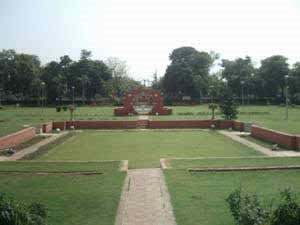SMALL PATCHES OF GREAT IMPORTANCE

“The nation that destroys its soil destroys itself” (Franklint De Rosevelt)
The origin of parks and gardens can be traced through 17th century when owners of the private residence of London opened their landscaped garden to the visitors of all social classes. Community pleasuring parks first emerged in London. Locally Duddeston Manor in Birmingham opened first commercial community park in the middle of 18th century. The early 19th saw the emergence to the urban “middle class” parks. Their purpose was to provide recreational and leisure opportunities to the contiguous population. During this period parks were seen as a slice of countryside on the doorstep of wealthy citizens and admission charges were made in order to keep them exclusive.
Urban parks and green spaces are an indispensable part of the urban heritage and infrastructure being a strong element in the architectural and landscape character of a city. Urban flora is on the 24 hours every day functioning for all of us to perk up our environment. Without parks and green spaces the city is a sterile landscape of concrete, bricks, steel and asphalt. They are major capital assets of cities and towns. So the existence of parks and green spaces in city master plan is a key of affluence, prosperity and enhanced quality of life. Their stipulation is advantageous for our rational and psychological health; colourful flowers present in the parks append innate character to our cities and towns and have a profound collision on our moods and emotions impossible to measure. Urban green spaces help to marmalade natural system, including carbon, water and other natural cycles with in the urban environment, supporting ecosystem and providing the disparity of living elements in both designed landscapes and a sagacity of solitude and sanctuary, postoperative hospital stays are curtained when patients are placed in rooms with a vision of trees and green spaces.
For the stabilization of inner city temperature and humidity green spaces have an idiosyncratic role. These help to calm the “heat island” effect in our inner cities, which is resulted from the storage of thermal energy in concrete. The collective effect of a large area of transpiring vegetation (evaporative water) reduces the air temperature, normalize the mugginess, minimize the glare of sunny days and sluggish down the wind alacrity. Plants are lungs of nature because these suck up the pollutants through the pores present on leaf surfaces. Plants present in green spaces provide opportunities for recycling of organic material and squat storm water runoff. Through the process of photosynthesis plants make available oxygen for us to breath. Plants manufacture enough oxygen on each acre for people every day and sop up carbon dioxide on each acre over a year’s time to equal the amount you produce, when drive your car 26000 mile.
Heat from the earth captivated in the atmosphere due to high levels of carbon dioxide and other heat trapping gases, which prohibit it from releasing into space, creating phenomenon is called green house effect. About the green house effect is caused by carbon dioxide and plants act as carbon sink for photosynthesis and storing it as cellulose in trunk while releasing oxygen back to atmosphere. A healthy tree stores about 13 pounds of carbon annually or 2.6 tons per acre each year. Up to 30% air conditioning needs are abridged in the presence of green vegetation. Combination of carbon dioxide removal, carbon storage in wood and cooling effect make plants an efficient tool for skirmishing against green house effects.
Green spaces and parks are a brawny element in the architectural and aesthetic structure of a city. These are important for social interaction, fostering community development and are compassionate to the economic renaissance of a city. Open spaces make available safe area of free association for friends, strangers and families. These endorse family values because recreating together ends to be closer and more cohesive. Married couples can enjoy better their free time in the parks as compared to the homes. Parks provide opportunities for community events, voluntary activity, charitable fund raising and community recreation, which promote racial and cultural harmony. These diminish rebellious behaviour, cultural diversity and adolescent criminal activity. Phoenix Arizona juvenile crime dropped 55% when recreational facilities were kept open until 2:00 A.M. Open spaces strengthen the neighborhood association, conquer the boredom, create the recollections, edify the vital life styles and provide space to enjoy nature. Apartments and offices in green areas rent more hastily; have higher rental rates and tenants reside longer. Property that is well landscaped with dazzling vegetation is always more desirable than property sitting on a barren land. Different surveys have shown that green vegetation can add up to 15% housing property. Offices and industrial space in a wood setting is in more demand and is more valuable to sell or rent.
Urban parks, gardens and recreational open spaces stimulate commercial growth and foster the inner city economic revitalization. These boost local economy by attracting tourists. Across U.S parks, river, scenic lands, wildlife areas and open spaces support $502 billion to tourism industry annually. National Park Services America estimated that national park visitors contributed $10 billion in direct and indirect benefits to local economy. As broad-spectrum benefits of the urban parks and green spaces are discussed in 1995 a nationwide study was conducted in Pennsylvania University of America, people responded the parks benefits as 42% personal benefits, 38% social benefits, 12% health benefits and 8% environmental benefits. While same research was also conducted in Pakistan under University of Agriculture Faisalabad (2003) and the responses were 35% health benefits 25% environmental benefits, 20% aesthetic benefits and 19% social benefits.
The tangible and intangible benefits of parks and green spaces cannot be denied but do we have these enough? City planners should incorporate the consents of these life saving patches in city master plans. Thirty percent of total urban settlement is recommended for parks and green spaces to retain quality of life and for the conservation of natural resources.
